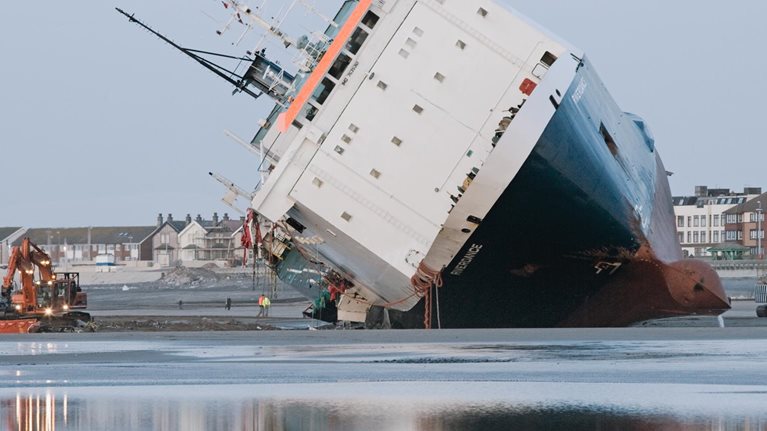Companies are walking a geopolitical tightrope. As political frictions inside and among regions heat up, the likelihood increases that they will affect a global enterprise’s operations, performance, or people.
The challenges that geopolitical risks create will get worse. In the next two decades, competition for global influence is likely to reach its highest level since the Cold War. That’s one finding from the US National Intelligence Council’s report Global Trends 2040: A more contested world.1 According to the report, no single locale is likely to dominate all regions or domains, and “a broader range of actors will compete to advance their ideologies, goals, and interests.”
Nowhere is the fallout from current geopolitical tensions more apparent than the unfolding competition between China and the United States. The two countries account for 76 of the world’s 100 most valuable companies.2 Channeling the policy debates under way in the European Union,3 many global companies are seeking their own form of “strategic autonomy” to navigate China–US relations. Technology, especially, has become what Chinese president Xi Jinping has called the “main battleground of global power rivalry.”4 Companies must consider how to harness capabilities such as 5G and AI without falling victim to geopolitically based regulatory or reputational cross fire.
Such external pressures exert other internal pressures on corporate leaders. Depending on the circumstance, a company’s leaders may have to weigh the effect that political or media scrutiny on the company’s operations in one area has on its holdings in other locales. They may have to balance, given the risks, near- and long-term market priorities. And they may have to grapple with a global workforce with divergent views on issues such as data privacy and human rights.
Any discussion of such potentially existential issues must start at the top. After consulting with top business leaders and legal, public-policy, and risk professionals at Fortune 500 companies in multiple industries, we suggest that company leaders can use a five-pronged approach to managing geopolitical risk.
1. Start with the board
Many company boards already deliberate geopolitical risks to one degree or another. But the discussions often focus on a specific investment, project, or market entry or exit. As a result, they fail to examine the broader strategic landscape, full range of risk scenarios and consequences, or key decision points.
Instead, boards can dedicate regular standing time to analyzing how to respond to the geopolitical risks that their enterprises face as part of a broader board effort to build more resilient companies. Not engaging in such discussions in the current geopolitical context would be malpractice.
One way to initiate a more strategic approach is by assessing the risks that matter the most to a business. The business’s board can apply a materiality test to pinpoint what it should dedicate time to discussing. For example, the Iran nuclear talks have significant regional and global consequences. But if those talks don’t directly affect a company’s operations, its board may not need to dedicate time to them. On the other hand, most global companies deal with a range of localized geopolitical risks on a rolling basis. Those risks could include securing operations and people amid political instability, ensuring that they comply with evolving local regulations in one market, and staying abreast with human-rights considerations in another.
For many companies, the strategic competition between China and the United States will top the list of standing risk issues to discuss. A board could begin such a conversation with a baseline assessment that includes the following:
- How we got here: historical context of China–US relations
- Where we are now: known knowns and unknowns
- Where we are headed: key watchpoints to track—four likely candidates are human rights and domestic politics; other governments’ positions on relevant policy and trade issues; strategic flash points, such as Taiwan; and trade and technology
- What to do about it: implications of the analysis and how to prioritize decisions about actions to take based on them
Boards can gain perspective by soliciting outside opinions on relevant topics from business and political leaders, embassies and other government agencies, and nongovermental organizations. Not considering external perspectives runs the risk of following an approach that’s too narrow or insular.
Providing a regular forum for a board to examine pressure points and operating realities from multiple perspectives and air diverging views doesn’t just improve decision making and establish an organization’s appetite for risk—it helps create consensus across leadership on the issues of the day. Such a consensus can create a set of guiding principles—and, as importantly, a set of trust-based relationships and mutual understanding across the organization—that enables rapid, purposeful reaction grounded in a shared set of priorities when risk scenarios play out.
2. Use a trifocal lens to assess potential risks
Organizations can be prepared to respond to geopolitical risks across multiple time frames. Creating short-term, midterm, and long-term response strategies ensures that a company can not only handle a fast-changing situation or emergency but also make the investments needed to seize opportunities and become more resilient.
Short-term actions
One short-term action that a company can take is establishing a crisis-response unit to take the lead on identifying potential risks and developing mitigation strategies. Such a unit could, for example, analyze political events that threaten to disrupt the company’s operations materially or prepare responses to government inquiries into sensitive topics.
Another short-term action is to invest in strategy, PR, and government-relations teams that can serve as the company’s points of contact with senior government officials and key stakeholders in multiple jurisdictions. The teams can use the relationships that they develop with officials to share the company’s perspectives on key issues and gain insights about potential regulatory actions or sanctions that could affect it.
Midterm actions
Holding regular briefing sessions with a company’s board and senior leaders on relevant geopolitical risks is a key midterm action. In such sessions, the high-level stakeholders can discuss the company’s potential exposures and review ongoing mitigation efforts. Discussions can focus on three risk areas: brand and reputation; operational issues, such as cybersecurity strategy; and products, services, and partnerships.
Long-term actions
As part of long-term planning, a company can conduct exercises to assess its response to game-changing scenarios. One test could explore the conditions in which the company may be compelled to ring-fence its IT infrastructure (to protect against cyberattacks or comply with regulatory requirements) or split off its business in a particular region. Such a test would include a time frame for execution and possible technical options.
Long-term planning can also cover such issues as the following:
- the most significant opportunities and challenges created by a constantly evolving geopolitical landscape and the investments or adjustments needed to address them
- potential unintended consequences from taking a particular risk position
- key takeaways from how peer companies responded to similar shock situations
3. Think critically about the corporate narrative
For both internal and external stakeholders, walking a geopolitical tightrope may cause leaders to redefine how they think about and position their companies. Some may, for commercial and strategic reasons, choose to strengthen ties to the countries where the companies are based. Others may opt to identify as global entities because of the access it accords them to pursue business opportunities in emerging markets. But in the age of instant information, the story a company tells about itself in one market won’t stay there. And a narrative that works in one place could inhibit market opportunities in another or create sensitivities among regions.
Part of managing geopolitical risk is considering the ramifications of a company’s core narrative. Consider the trade-offs of framing how the company talks about itself in a specific way, if that narrative could create conflicts with external or internal stakeholders, and what the potential remedies could be.
4. Deploy refreshed risk frameworks and guidelines
If companies operate in markets that are high risk because of political instability or the threat of international sanctions, they can develop market-specific assessments or “compacts” that fuse corporate strategy and risk management. Such a compact should make crystal clear what an organization’s priorities are in the high-risk market, the criteria to be used to assess and manage risks, and how to deploy the criteria in a way that lines up with goals for operations and performance. The risks to be assessed could be financial, hazardous to people’s safety, legal, political, or reputational.
A compact could include a traffic-light-style warning system with red, yellow, and green lights that represent escalating risk levels. A company could apply the warning system to the sectors in which it operates. It could also apply the system to the entities with which it does business, separating those with which a local office can work without needing additional approval from those that need risk approval and those with which an office should never work with.
Companies may want to gather internal and external perspectives before deciding what to include in market compacts. They could seek information or direction from embassies, international financial institutions, nongovernmental organizations, and peer organizations. Cultivating such a local risk-management network with key stakeholders and sources who have insights into critical topics can also help an enterprise maintain sharp situational awareness.
Compacts provide strategic guidance for engaging within a country. Prudent geopolitical risk management also requires understanding how to deal with issues that cross borders. For that reason, a company may need to issue guidance on a range of other topics, such as the appropriate way to discuss geopolitically sensitive topics in publications or speeches and how to depict contested borders on maps.
5. Secure stakeholders’ hearts and minds
Geopolitics is personal. A large organization is likely to have stakeholders with differing cultural reference points and opinions on issues such as human rights and privacy. And differences can dissolve into disagreements about risk and strategy. People may worry that a company will hold itself to different standards in different regions. In a world where nationalistic sentiments are on the rise, no country dominates, and regulations and standards are fragmenting, such situations are bound to accelerate.
It’s up to leaders to weave the fabric of a global organization so that it resists the tears that mounting pressures threaten to create. Leaders can cultivate cohesiveness by bringing key stakeholders to the table to share views on a given engagement or project. In such discussions, it’s of utmost importance to make sure that all affected geographic regions are represented. Otherwise, internal fissures can build and burst in a way that damages culture, reputation, and performance.
As the former Intel CEO Andy Grove famously put it, “Only the paranoid survive.”5 With tectonic shifts in geopolitics rumbling from China’s reemergence on the global stage, a climate crisis, and the Fourth Industrial Revolution, companies must be on guard. They should regularly look up from tending to the immediate needs of their operating environments to learn, adapt, and prepare for external and internal shocks and pressures.


